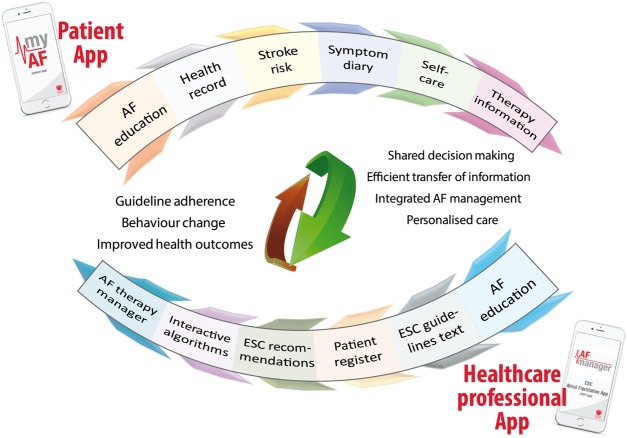Novel Smartphone and Tablet Apps for patients and healthcare professionals have been developed by the European Society of Cardiology based on the 2016 ESC Guidelines for Atrial Fibrillation
2016 saw the release of the new European Society of Cardiology (ESC) Guidelines on Atrial Fibrillation (AF), which highlighted the importance of patient-centred care within a multidisciplinary team in order to improve management of AF and reduce adverse clinical outcomes. The application of best-practice guidelines can be challenging in the clinical environment and mobile applications are a technological advance with the potential to aid clinicians and also educate and involve patients.
The ESC and the CATCH ME Consortium have created two applications (Apps) for use in smartphones and tablets. The patient App aims to enhance patient education, improve communication between patients and health care professionals and encourage active patient involvement in the management of their condition. The healthcare professional App is designed as an interactive management tool incorporating the 2016 ESC Practice Guidelines on AF and supported by the European Heart Rhythm Association (EHRA).
Both Apps are freely available now for Android and iOS devices through the Google Play, Amazon and Apple stores.
Introduction
Applications (Apps) on smartphones and tablet computers are now almost universal as the proportion of the global population that have access to mobile devices continues to grow exponentially. For many people, smartphones and tablets are now the main tools used for communication and to access the internet. Health-related Apps are also becoming more common and offer education within a platform that can integrate complex clinical pathways. The European Society of Cardiology (ESC) already has a series of Apps based on the pocket treatment guidelines which are extremely successful (predicted to reach 1 million user sessions per year by the end of 2017). Developing interactive Apps that can guide clinicians through management choices based on individual patient characteristics has the potential for further clinical value and increased guideline adherence. Including patients within this digital framework would not only improve efficiency for consultations but also contribute to patient education, shared decision making and better compliance with treatment.
Atrial fibrillation (AF) is an ideal cardiovascular condition to further develop this concept, underpinned by the 2016 ESC Guidelines on AF.1 AF continues to increase in incidence and prevalence with high rates of morbidity and mortality.2 Adherence to clinical practice guidelines can improve prognosis in patients with AF3–5 and integrated, patient-centred care can increase therapeutic benefit and reduce unnecessary hospitalization.6–8 Apps in other health care areas have suggested a benefit from various types of intervention in selected populations.9 In addition, digital formats have the potential to embed learning within routine clinical practice,10 and Professional Standards across Europe highlight the importance of patient and physician education.11,12 These provide a clear rationale to develop ESC-based interactive App.
We have designed two standalone Apps, one for patients and the second for health care providers (general and specialist doctors, AF nurses and others). These will then be linked in the near future to allow transfer of data securely between patients and their AF management team (and vice versa). Our overall aim is to facilitate best-practice management of AF and therefore to improve patient outcomes.
Design
App design was led by representatives from the ESC Guidelines Task Force on AF, the CATCH ME Consortium (Characterizing Atrial fibrillation by Translating its Causes into Health Modifiers in the Elderly) and the European Heart Rhythm Association (EHRA). Börm Bruckmeier Publishing (Germany) was commissioned to produce the Apps. The Apps were developed in tandem with the writing of the 2016 ESC Guidelines on AF (2014–2016).
The main components and objectives of the App development programme are displayed in Figure 1.
Figure 1.
Components and objectives of the App development programme. AF, atrial fibrillation; ESC, European Society of Cardiology.
Educational material in the patient App was edited by a team of patient representatives with AF, funded through a UK National Institute of Health Research grant on improving patient outcomes in AF.13 Text and images were derived from the British Heart Foundation (https://www.bhf.org.uk/), the German National Network of Competence in Atrial Fibrillation (AFNET; http://www.kompetenznetz-vorhofflimmern.de/) and a patient booklet on AF developed in the Netherlands.14 The patient App will present information on individual stroke risk and provide a personal health record and symptom diary to facilitate consultation with their healthcare professional.
The health care professional App is a more complex tool, allowing both conventional viewing of guideline text, recommendations and flowcharts, as well as interactive treatment algorithms that will guide clinicians through the decision process.
Both Apps are scheduled for public release during the ESC Congress in Barcelona, August 2017. Connectivity between the Apps (via a secure cloud server) and CE certification will follow shortly afterwards.
Evaluation
The Apps have been extensively evaluated in multiple stages and ongoing feedback will drive further development of these tools.
The content was appraised by members of the ESC AF Guidelines Task Force, followed by internal and external beta-testing to ensure an optimal interface design, good use of technology and acceptability to users.15,16 In total, there were 50 test versions of the Apps, with step-wise iterations leading to better functionality.
Discussion
We live in an exciting (and confusing!) technological time with an unrelenting pace of advance in digital devices. The main challenge for health care is stay up-to-date in this evolving field and provides tools which are clinically relevant and can improve patient care.
With the need for structured and integrated management, AF is a good test case for the development of interactive Apps, based on recommendations and treatment flowcharts from the 2016 ESC AF Guidelines.1 Uniquely, we have also designed a companion patient App which can harness informed and autonomous patients, leading to better outcomes through shared decision making.6,17,18
Not all patients and health care professionals will have access to smartphones or tablets, however, even in older adults, internet use and mobile phones are increasing exponentially.19 Barriers to smartphone use in older patients, such as familiarity and visual impairment,20 were considered during the design phase of the Apps and addressed with the use of ‘patient-friendly’ information and a simple layout. The structure of the Apps will allow future modification in response to feedback, as well as the opportunity to collect anonymous data from patients who give consent and thereby assess challenges to guideline-adherence over time.
Get your AF App now!
The Apps are freely available for Android and iOS devices through the Google Play, Amazon and Apple stores. Just scan the barcode images, or search for ‘My AF’ (patient App) or ‘AF manager’ (health care professional App) in the Appstore. You can find treatment guidelines for other cardiovascular conditions in the ESC Pocket Guidelines App (search for ‘ESC’).
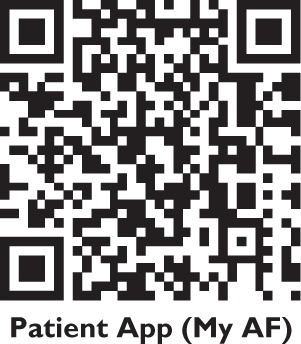
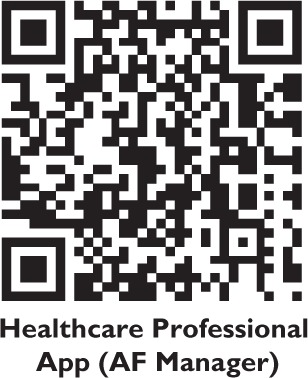
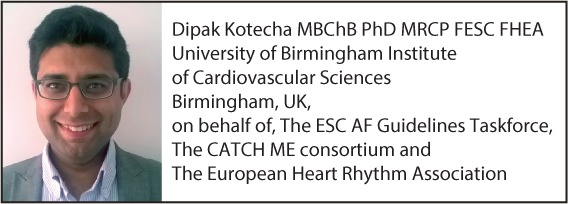
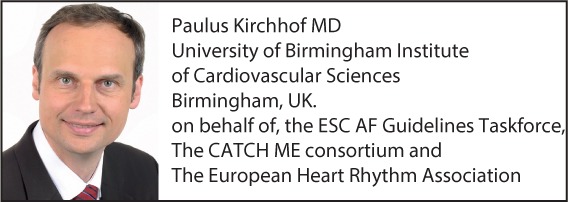
Address for correspondence: Dr Dipak Kotecha MBChB PhD MRCP FESC FHEA University of Birmingham Institute of Cardiovascular Sciences, The Medical School, Vincent Drive, Edgbaston, Birmingham, B15 2TT, United Kingdom. d.kotecha@bham.ac.uk Tel: +44 121 371 8122 Fax: +44 121 371 4175
Supplementary Material
Acknowledgements
We would like to thank Dr Marios Hadjianastasis (Centre for Learning and Academic Development, University of Birmingham) and the many people who contributed to beta-testing.
Funding
The smartphone and tablet applications have been funded by the CATCH ME Consortium (EU Horizon 2020 Grant 633196) and the European Society of Cardiology. D.K. is supported by a National Institute of Health Research (NIHR) Career Development Fellowship (CDF-2015-08-074). The opinions expressed in this article are those of the authors and do not represent the EU, the NIHR or the UK Department of Health.
Conflict of interest: D.K. reports professional development support from Daiichi Sankyo, grants from Menarini, and lecture fees from AtriCure, all outside the submitted work. P.K. reports consulting fees, honoraria and research grants from 3 M Medica, MEDA Pharma, AstraZeneca, Bayer Healthcare, Biosense Webster, Boehringer Ingelheim, Bristol-Myers Squibb, Cardiovascular Therapeutics, Daiichi-Sankyo, German Cardiac Society—Akademie, Johnson & Johnson, Medtronic, Merck, MSD, OMRON, Otsuka Pharma, Pfizer, Sanofi, St. Jude Medical, Servier, Siemens, TAKEDA, German Federal Ministry for Education and Research (BMBF), Fondation Leducq, German Research Foundation (DFG), British Heart Foundation, Medical Research Council UK, all outside the submitted work; grants from EU Horizon 2020 (CATCH ME) during the conduct of the study; in addition, P.K. is listed as an inventor on two patent applications submitted by University of Birmingham on Atrial Fibrillation Therapy (GB1404998.5) and Markers for AF (GB1413081.9).
References
References are available as supplementary material at European Heart Journal online.
Associated Data
This section collects any data citations, data availability statements, or supplementary materials included in this article.



